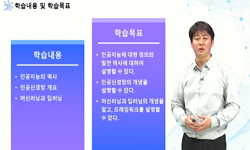Purpose: The purpose of this study is to explore innovative teaching methods to enhance the effectiveness of university major courses which is “Service interview practice ll” through the synergy between Artificial Intelligence (AI) and Human Intel...
http://chineseinput.net/에서 pinyin(병음)방식으로 중국어를 변환할 수 있습니다.
변환된 중국어를 복사하여 사용하시면 됩니다.
- 中文 을 입력하시려면 zhongwen을 입력하시고 space를누르시면됩니다.
- 北京 을 입력하시려면 beijing을 입력하시고 space를 누르시면 됩니다.

Exploring Innovative Teaching Methods in University Major Courses through the Synergy of AI and HI
한글로보기https://www.riss.kr/link?id=A109242489
- 저자
- 발행기관
- 학술지명
- 권호사항
-
발행연도
2024
-
작성언어
-
- 주제어
-
KDC
300
-
등재정보
KCI등재후보
-
자료형태
학술저널
-
수록면
34-47(14쪽)
-
비고
학회 요청에 의해 무료로 제공
- 제공처
-
0
상세조회 -
0
다운로드
부가정보
다국어 초록 (Multilingual Abstract)
Method: This research was conducted by analyzing a course that took place over one semester. Following the ADDIE model, the course syllabus was reviewed, and improvement points were derived based on student evaluations. The researcher utilized AI tools to generate course plans and assessment criteria, collecting various responses in the process to ultimately select the most suitable outcomes. This methodology facilitated a collaborative approach between AI and HI.
Results: The analysis of the course syllabus revealed that overall course objectives, as well as the concepts of coaching by instructors, peer coaching, and self-coaching, were clearly articulated, and assessment criteria were strengthened. Notably, the introduction of results-oriented goal-setting allowed students to conduct self-assessments after midterm exams through discussions with instructors, thereby establishing a framework to monitor learner progress. The assessment methods were divided into external and internal evaluations, providing a foundation for more systematic and specific feedback.
Conclusion: This study emphasizes the need for continuous enhancement of teaching effectiveness through collaboration between AI and HI. It particularly suggests that the design of major courses should enable learners to acquire competency-based skills, highlighting the necessity for the development and improvement of diverse teaching methods. Future research should seek ways to improve classes by leveraging the various functionalities of AI and expanding the possibilities of generative AI. These efforts will ultimately contribute to enhancing the quality of higher education.
Purpose: The purpose of this study is to explore innovative teaching methods to enhance the effectiveness of university major courses which is “Service interview practice ll” through the synergy between Artificial Intelligence (AI) and Human Intelligence (HI). To achieve this, a quality management system for the curriculum was established based on the ADDIE model, and the direction for curriculum improvement was presented through learner needs analysis and the setting of learning objectives. The study aims to contribute to the development of learner-centered curricula by effectively utilizing AI technologies.
Method: This research was conducted by analyzing a course that took place over one semester. Following the ADDIE model, the course syllabus was reviewed, and improvement points were derived based on student evaluations. The researcher utilized AI tools to generate course plans and assessment criteria, collecting various responses in the process to ultimately select the most suitable outcomes. This methodology facilitated a collaborative approach between AI and HI.
Results: The analysis of the course syllabus revealed that overall course objectives, as well as the concepts of coaching by instructors, peer coaching, and self-coaching, were clearly articulated, and assessment criteria were strengthened. Notably, the introduction of results-oriented goal-setting allowed students to conduct self-assessments after midterm exams through discussions with instructors, thereby establishing a framework to monitor learner progress. The assessment methods were divided into external and internal evaluations, providing a foundation for more systematic and specific feedback.
Conclusion: This study emphasizes the need for continuous enhancement of teaching effectiveness through collaboration between AI and HI. It particularly suggests that the design of major courses should enable learners to acquire competency-based skills, highlighting the necessity for the development and improvement of diverse teaching methods. Future research should seek ways to improve classes by leveraging the various functionalities of AI and expanding the possibilities of generative AI. These efforts will ultimately contribute to enhancing the quality of higher education.
목차 (Table of Contents)
- 1. Introduction
- 2. Research Methodology and Development Process
- 3. Conclusion and Utilization Plan
- 4. Future Development Plans and Suggestions
- 5. References
- 1. Introduction
- 2. Research Methodology and Development Process
- 3. Conclusion and Utilization Plan
- 4. Future Development Plans and Suggestions
- 5. References
동일학술지(권/호) 다른 논문
-
Areas of Ethical Inquiry Related to Artificial Intelligence
- J-INSTITUTE
- Gyunyeol Park(Gyunyeol Park)
- 2024
- KCI등재후보
-
Creativity and AI: Products of Generative AI and Ethical Issues
- J-INSTITUTE
- Hyunsoo Kim(Hyunsoo Kim)
- 2024
- KCI등재후보
-
- J-INSTITUTE
- Sunggu Jo(Sunggu Jo)
- 2024
- KCI등재후보




 스콜라
스콜라






